Studies of hysteresis and quantum tunnelling of the magnetisation in dysprosium(iii) single molecule magnets†
Abstract
We report magnetic hysteresis studies of three Dy(III) single-molecule magnets (SMMs). The three compounds are [Dy(tBuO)Cl(THF)5][BPh4] (1), [K(18-crown-6-ether)(THF)2][Dy(BIPM)2] (2, BIPM = C{PPh2NSiMe3}2), and [Dy(Cpttt)2][B(C6F5)4] (3), chosen as they have large energy barriers to magnetisation reversal of 665, 565, and 1223 cm−1, respectively. There are zero-field steps in the hysteresis loops of all three compounds, that remain in magnetically dilute samples and in samples that are isotopically enriched with 164Dy, which has no nuclear spin. These results demonstrate that neither dipolar fields nor nuclear hyperfine coupling are solely responsible for the quantum tunnelling of magnetisation at zero field. Analysing their vibrational modes, we find that the modes that most impact the first coordination sphere occur at the lowest energies for 1, at intermediate energies for 2 and at higher energies for 3, in correlation with their coercive fields. Therefore, we suggest that the efficiency of quantum tunnelling of magnetisation is related to molecular flexibility.



 Please wait while we load your content...
Please wait while we load your content...